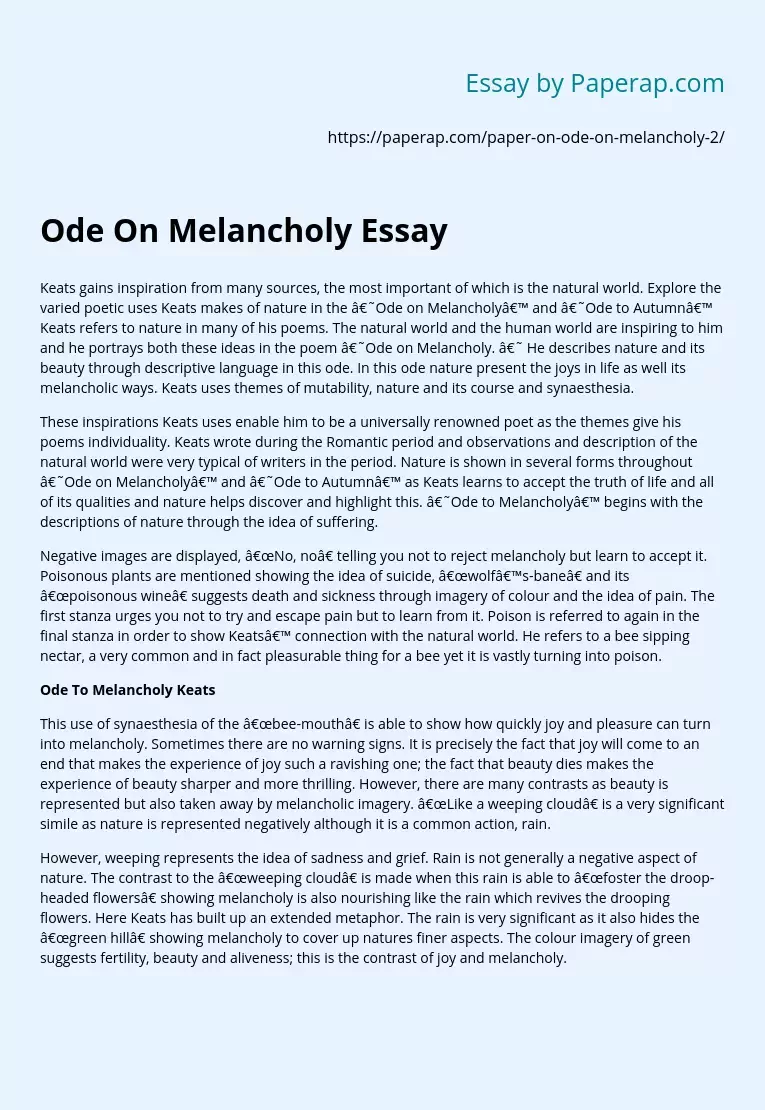Keats gains inspiration from many sources, the most important of which is the natural world. Explore the varied poetic uses Keats makes of nature in the ‘Ode on Melancholy’ and ‘Ode to Autumn’ Keats refers to nature in many of his poems. The natural world and the human world are inspiring to him and he portrays both these ideas in the poem ‘Ode on Melancholy. ‘ He describes nature and its beauty through descriptive language in this ode. In this ode nature present the joys in life as well its melancholic ways.
Keats uses themes of mutability, nature and its course and synaesthesia.
These inspirations Keats uses enable him to be a universally renowned poet as the themes give his poems individuality. Keats wrote during the Romantic period and observations and description of the natural world were very typical of writers in the period. Nature is shown in several forms throughout ‘Ode on Melancholy’ and ‘Ode to Autumn’ as Keats learns to accept the truth of life and all of its qualities and nature helps discover and highlight this.
‘Ode to Melancholy’ begins with the descriptions of nature through the idea of suffering.
Negative images are displayed, “No, no” telling you not to reject melancholy but learn to accept it. Poisonous plants are mentioned showing the idea of suicide, “wolf’s-bane” and its “poisonous wine” suggests death and sickness through imagery of colour and the idea of pain. The first stanza urges you not to try and escape pain but to learn from it.
Poison is referred to again in the final stanza in order to show Keats’ connection with the natural world. He refers to a bee sipping nectar, a very common and in fact pleasurable thing for a bee yet it is vastly turning into poison.
This use of synaesthesia of the “bee-mouth” is able to show how quickly joy and pleasure can turn into melancholy. Sometimes there are no warning signs. It is precisely the fact that joy will come to an end that makes the experience of joy such a ravishing one; the fact that beauty dies makes the experience of beauty sharper and more thrilling. However, there are many contrasts as beauty is represented but also taken away by melancholic imagery. “Like a weeping cloud” is a very significant simile as nature is represented negatively although it is a common action, rain.
However, weeping represents the idea of sadness and grief. Rain is not generally a negative aspect of nature. The contrast to the “weeping cloud” is made when this rain is able to “foster the droop-headed flowers” showing melancholy is also nourishing like the rain which revives the drooping flowers. Here Keats has built up an extended metaphor. The rain is very significant as it also hides the “green hill” showing melancholy to cover up natures finer aspects. The colour imagery of green suggests fertility, beauty, and aliveness; this is the contrast of joy and melancholy.
Rain and sadness are able to hide nature’s beauties. This contrast is almost made in “April shroud” which has oxymoronic ideas as April is the month of nature’s renewal, a pleasant setting and shroud is a cloth used for death. This portrays the idea of the mutability of life. Sadness needs to be accepted in order to enjoy life’s pleasures. Nature is a source of melancholy and like some aspects of nature, such as rainbows and waves, melancholy is not always long lasting. It is meant to be temporary, as life has many emotions through the human world as well as the natural world.
Ode On Melancholy Essay. (2019, Dec 05). Retrieved from https://paperap.com/paper-on-ode-on-melancholy-2/

